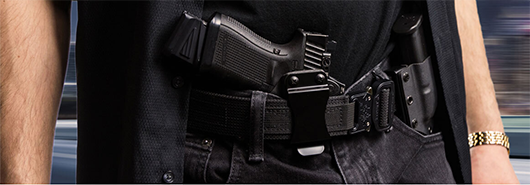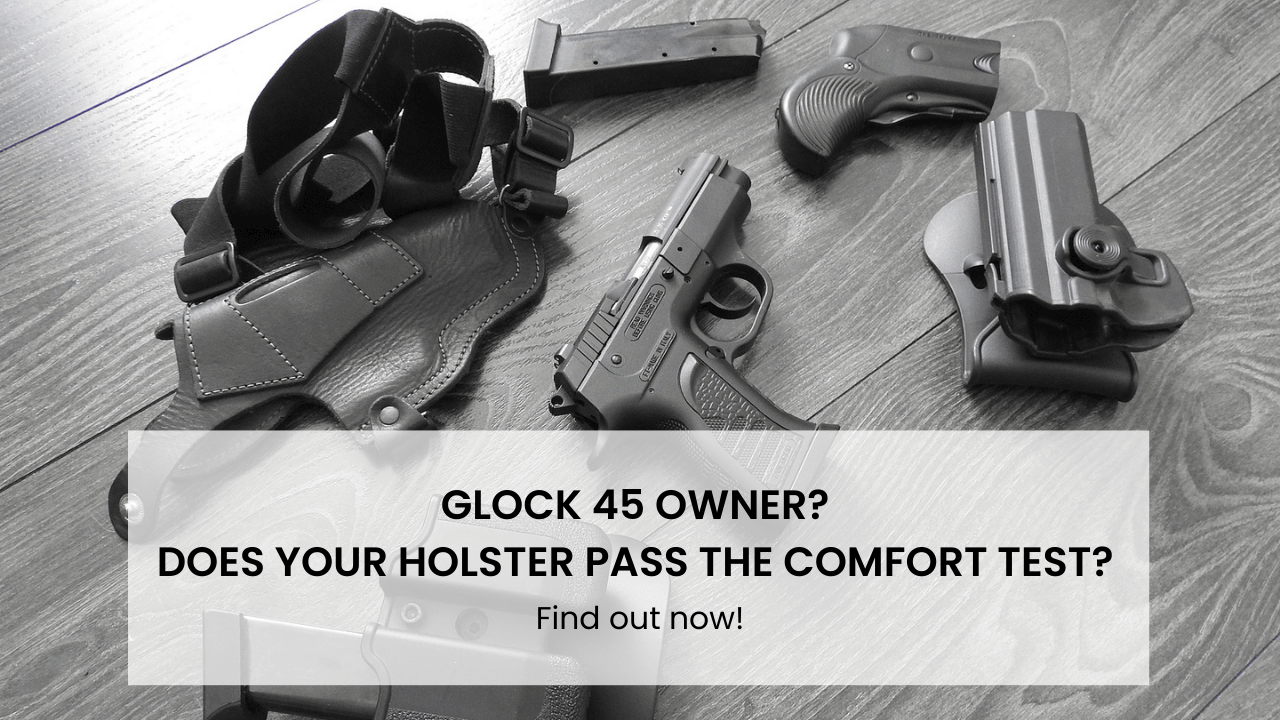How to Draw From Concealment - Appendix Carry Holster
Feb 22nd 2021

Appendix carry is the practice of concealed carrying a handgun inside the waistband with your holster located in front of your body. This carry method placed your gun at or around the 12-o’clock position.
This carry method is one of the most popular alternatives to the strong-side hip position, offering several advantages but imposing particular challenges.
Is Appendix Carry for Me?
Although it is nothing new, the popularity of appendix carry has been rising since the mid-2010s and is now a commonly-accepted carry method.
The appendix position makes it easier to conceal your firearm, as it is not hanging from the side of your hip.
Many shooters also find drawing from the appendix position is more natural, as our hands are naturally drawn forward of the body instead of hanging by the sides.
For most seasoned shooters, drawing from the appendix position is potentially much faster than from the strong-side hip or behind the back. With proper practice and training, drawing the gun very quickly and achieving fast draw times is possible.
There are several challenges to keep in mind when carrying in the appendix position. This carry position requires extra care and attention toward safety. In this position, your handgun is pointed either directly at your crotch or your femoral artery.
Accidents or negligence resulting in an unintentional discharge may have fatal consequences. Always be mindful of your trigger finger when holstering your firearm.
Many training instructors and combat specialists, including the late Todd Greene, recommend concealed carriers to be slow and methodical during the holstering process.
Another critical consideration is using a proper holster. Traditional IWB holsters are not recommended and may even be unsafe for appendix carry use. OWB holsters are not suitable either, as appendix carry is specifically an IWB carry method.
Fortunately, purpose-built Appendix Inside the Waistband (AIWB) concealed carry holsters are available, eliminating the need to use an ill-filling holster. AIWB holsters typically offer the best retention. Because this carry position places your gun directly in front of you and requires a nearly vertical motion to draw out of it, it makes it very challenging for anyone to try and grab or steal it out of your holster.
Drawing From The Appendix Position

Carrying from the appendix position requires knowing and practicing specific draw strokes to achieve a fast and safe draw.
It is preferable to practice all drawing and holstering drills with a training (blue) gun or dry-firing your carry gun before attempting them with live ammo. Practicing with a live firearm should only be done in a suitable environment (e.g., a gun range that allows drawing from the holster) and only when you are sufficiently safe and confident to avoid negligent discharges.
Although there are methods to practice the draw with your shirt or cover garment tucked into your waistband, making the holster visible, these methods do not prepare the shooter to deal with cover garment issues. Always practice drawing from concealment so you can find the motions that suit you best.
The five steps to draw from the appendix position:
- Grab the cover garment firmly
- Clear the cover garment out of the way
- Grip the handgun high and tight before drawing
- Rip the gun out of the holster
- Present the gun in position, transitioning from drawing to aiming
Starting from a standing position with your hands at rest, use your support hand to grab your shirt with a full, four-fingered grasp roughly over your holster’s location, ensuring that it does not snag against the holster or the gun when you’re pulling your shirt up.
Once you have a good grasp on your shirt or cover garment, don’t hesitate to pull it entirely up and clear the way for your holster. What it means is to not merely pull it up but also drag it away from your strong hand’s side.
Doing so will prevent your strong hand from being stuck in your shirt as you reach for your gun; this is particularly important if your appendix carry setup is a cross-draw, as it is more likely for your hand to get caught against your shirt during the drawing process.
After clearing your cover garment and exposing your holster, reach for your handgun and establish a high and tight grip before drawing. Most of the challenge is establishing proper palm placement as you reach for your handgun, then ensuring your grip’s firmness as you perform the draw.
Merely pulling the handgun up and out of the holster without paying attention to your grip will force you to re-adjust later on, which will hurt your draw times and increase the risk of fumbling.
A proper high and tight grip ensures that you can keep control of your weapon in a self-defense situation, such as when an attacker is trying to take it from you or slap it out of your hands.
Don’t forget safety basics; keep your finger away from the trigger guard as you practice drawing, even with a blue gun or an empty gun. For peace of mind, you can keep your index finger lifted up and away as you practice your grip.
Once you have a firm and established grip, rip the handgun deliberately and forcefully out of the holster using your strong hand, with your support hand still keeping your cover garment out of the way.
Quality AIWB holsters should provide secure retention of your handgun and require some deliberate force to draw and pull out. Still, you’re not guaranteed to always draw from a comfortable position. You may need to draw while bending, taking cover, or moving; such situations may alter the amount of force necessary to unholster.
Practicing your draws using a little more force than necessary to unholster your gun helps you drill a good habit in less than ideal conditions.
When your handgun has left the holster, you are transitioning from drawing to aiming, at which point you will be presenting your gun on the target, getting in position for shooting.
The actual method of presenting your gun on target may vary significantly depending on your preferences and situation, whether you shoot one-handed or two-handed, Isosceles or Weaver stance, and so on.
Regardless of your preferred shooting stance, transitioning from drawing to aiming has the same fundamentals: rotating your muzzle toward the target and raising the gun at eye level to acquire a sight picture.
In some situations, it may be advantageous to simply rotate the gun in the target’s general direction without raising (such as in extreme close-quarters). However, most of the time, you should present the gun correctly and assume that you will be aiming at the target using your gun’s sights.
If you shoot with a two-handed grip, such as an Isosceles or Weaver stance, this is when you can let go of your cover garment and bring your support hand in position.
If your handgun uses a frame-mounted manual safety that can be comfortably actuated with your support hand’s thumb (e.g., 1911), this is the moment to disengage it.
The only point where your finger can enter the trigger guard and begin touching the trigger is when you have fully transitioned from drawing to aiming when you are ready to shoot. Do not preemptively let your finger slip onto the trigger during the transition to shave off a few milliseconds; you risk a negligent discharge.
The Last Word
Speed should not come at the cost of safety. A responsible concealed carrier should practice as often as possible until they are both fast and safe, particularly with an appendix carry setup.
Whether you are new to concealed carrying or an experienced shooter, Incognito Concealment offers a selection of high-quality Kydex holsters compatible with most handguns available on the market, inside or outside the waistband.
For y questions, requests, or information, please call us at (586) 333-4240.











